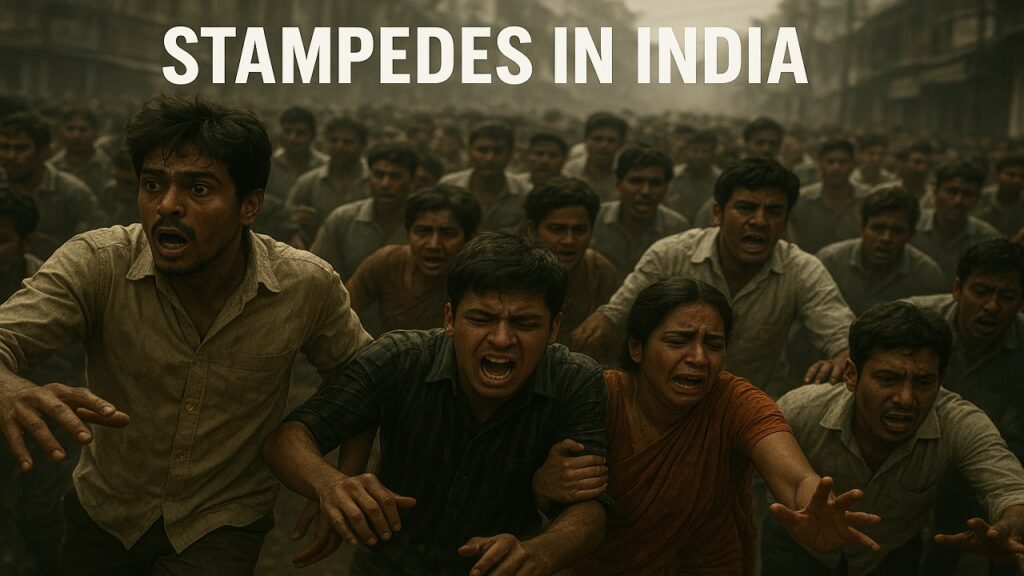Stampedes in India: Lessons in Scientific Crowd Control
Context

- Recently, a political rally by actor Vijay, founder of Tamilaga Vettri Kazhagam (TVK) in Karur district, Tamil Nadu, ended in a fatal crowd crush, resulting in the death of 41 people.
- This incident has reignited concerns over India’s preparedness for managing mass gatherings during religious, political, cultural, and sporting events.
- India has witnessed recurrent stampedes in 2025 alone, highlighting systemic gaps in crowd management and public safety.
Recent Major Stampedes in India
- M. Chinnaswamy Stadium, Bengaluru (June 4, 2025): 11 fans killed during IPL victory celebrations.
- Puri Gundicha Temple, Odisha (June 29, 2025): 3 killed during Rath Yatra festival.
- Shree Lairai Devi Temple, Goa (May 3, 2025): 7 deaths during Lairai Jatra festival on a slope.
- New Delhi Railway Station (February 15, 2025): 18 killed and more than a dozen injured due to overcrowding.
- Prayag Maha Kumbh Mela, Uttar Pradesh (January 29, 2025): At least 30 deaths during a holy dip on Mauni Amavasya.
- Lord Venkateswara Swamy Temple, Andhra Pradesh (January 8, 2025): 6 devotees killed while jostling for free tickets.
National-Level Measures
- BPR&D Guidelines (June 2025):
- Issued by Bureau of Police Research and Development.
- Emphasises scientific crowd management, risk assessment, and coordination for law enforcement.
- NDMA Recommendations (2020 onwards):
- Guides on managing crowds at mass gatherings.
- Includes site layout planning, ingress and egress routes, real-time monitoring, and communication protocols.
- NIDM Training Modules:
- Capacity-building programmes to train officials on handling large congregations safely.
- Indian Railways Manual (2025):
- Updated for 60 high-footfall stations.
- Introduced holding areas, dispersal zones, and crowd monitoring mechanisms.
Note: Most measures are advisory and not legally enforceable.
State-Level Measures
- Karnataka (2025):
- Crowd Control Bill covers political rallies, cultural programmes, and other events.
- Assigns responsibility to organisers and empowers district magistrates to cancel events, regulate loudspeakers, and impose fines or imprisonment.
- Uttar Pradesh (2023):
- State Disaster Management Authority guidelines formalise measures for religious and cultural events.
- Gujarat:
- Training manuals by Gujarat Institute of Disaster Management include site capacity planning, exits, volunteer training, first aid, and fire safety.
- Uttarakhand:
- Directed safety arrangements at major temples and removal of encroachments around shrines.
- Maharashtra (2025):
- Bill empowers Nasik-Trimbakeshwar Kumbh Mela Authority to authorise temporary facilities and bypass certain urban planning norms.
- Local Enforcement Agencies:
- Circulated SOPs for crowd control, coordination between departments, medical preparedness, and fire safety protocols.
- Directed organisers to prepare crowd management plans, limit crowd size, deploy medical teams, set up barricades, and divert routes.
- These remain administrative orders without legal backing.
Scientific Crowd Control
- Controlling Crowd Density:
- Risk increases sharply at 5 persons per sq. m.
- Use of Technology:
- Drones and real-time cameras help monitor crowd density continuously.
- Avoiding Hazardous Areas:
- Crowds should not be channelled into bottlenecks, slopes, or counter-flows.
- Managing Movement:
- Individuals advised to move diagonally, towards less dense edges, avoiding resistance to the flow.
- Compressive Asphyxia:
- Main cause of fatalities rather than trampling.
- Occurs when external pressure on chest or abdomen prevents lung expansion, causing oxygen deprivation.
- Survival strategies: forearms across chest, staggered footing, roll sideways if knocked down, protect head and neck, and rise quickly.
- Avoiding Rigid Barriers:
- Walls, fences, and stages can dangerously increase pressure.
- Best Practices for Organisers:
- Real-time monitoring by trained managers.
- One-way traffic routing and multiple exits.
- Clear signage and public announcements.
- On-site medical teams and first aid facilities.
Conclusion
- Stampedes in India are not isolated incidents but a reflection of systemic gaps in crowd management.
- While national and state guidelines exist, enforceable legal frameworks are largely absent.
- The way forward includes:
- Adoption of scientific crowd management methods.
- Legal accountability for organisers.
- Empowering local authorities with statutory backing.
- Use of technology such as drones, AI-based monitoring, and real-time data systems.
- Implementing these measures effectively can prevent tragedies like the Karur rally and ensure public safety during mass gatherings.
Source : The Hindu
